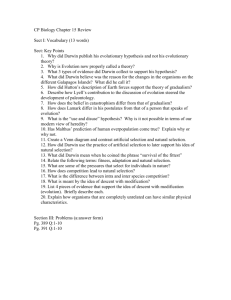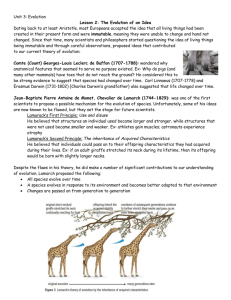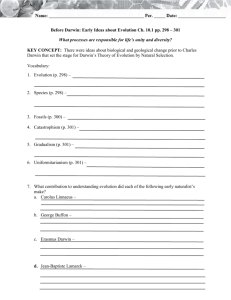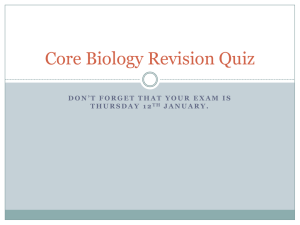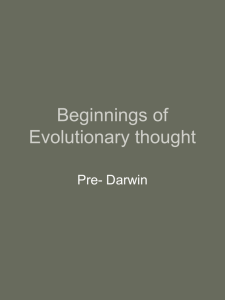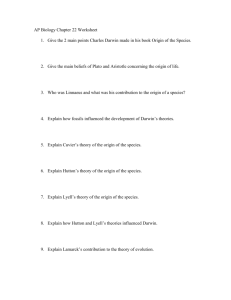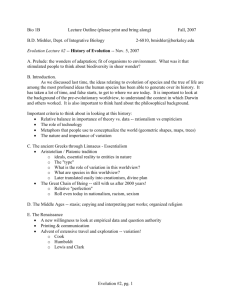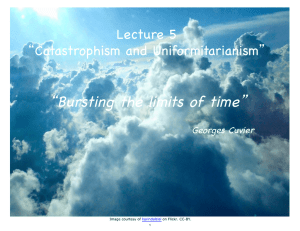Evolution: Did it begin with Origin of the Species?
advertisement
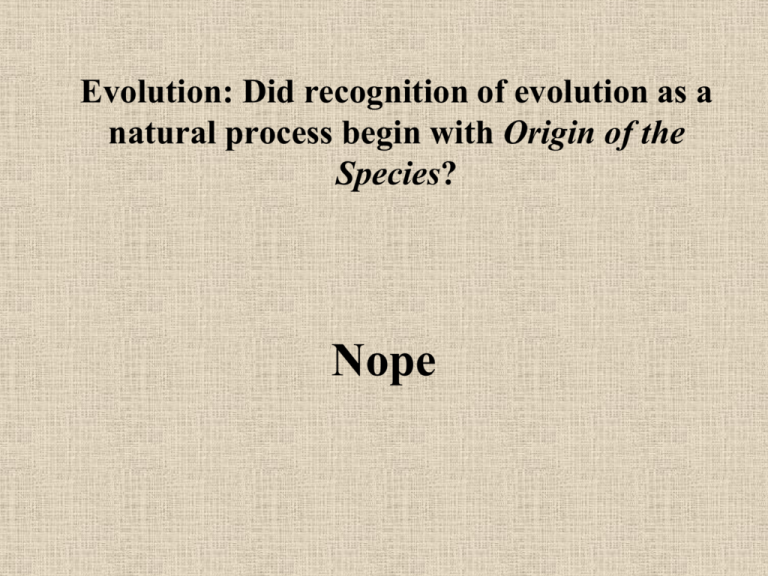
Evolution: Did recognition of evolution as a natural process begin with Origin of the Species? Nope Evolution was discussed and debated for over 100 years before Darwin published his work These discussions helped lay the foundation for Darwin’s Theory of Evolution by Natural Selection Changes in Scientific Thought Through Observation and Investigation • Judeo-Christian culture - species were individually designed and permanent • Natural Theology – 1700s, discover the Creator’s plan by studying nature • Natural Theology was based on the body of knowledge available at that time Carolus Linnaeus and Taxonomy • Reveal steps of life fashioned by the Creator • Science of taxonomy came of this • Linnaeus’ classification system was important to Darwin’s work • System is still in use today Fossils and Cuvier • Relics or impressions of remains of organisms • Intense study of fossils began in 1700s (paleontology) • Found in sedimentary rock, revealed by erosion Paleontology refined as a science by Georges Cuvier (1769-1832) Fossils and Cuvier • Cuvier recognized fossils deposited in layers (strata) • Observed that species disappeared and new ones appeared in different strata • Disagreed with evolutionists of his time Catastrophism • Cuvier proposed that each boundary between strata corresponded to some catastrophic event • Event destroyed many of the taxa present at time • Event was localized • New species came from unaffected areas Catastrophism • Cuvier’s worked in a limited geographic area • Later discoveries of similar strata in other areas revuted Cuvier’s theory Gradualism • James Hutton (1726-1797) proposed a theory that contrasted with Cuvier’s • Gradualism • Geological formations are the product of slow but continuous processes • Influential in the understanding of evolution Uniformitarianism • Charles Lyell (1797-1875) • Incorporated gradualism into his theory of uniformitarianism • Rate at which geological processes occur has stayed the same throughout Earth’s history • These rates meant Earth had to be older than 6,000 years Lamark: An Evolutionary Theory • Jean Baptiste Lamark (17441829) • Proposed the first comprehensive model of how life evolves • Published in 1809 (year Darwin was born) • Lamark studied invertebrates • Lineages from fossils to living species Lamark: An Evolutionary Theory • Perceived evolution as an organism’s attempt to achieve perfection • Innate tendency toward greater complexity • Equated increased complexity with perfection • As organisms attained perfection, they were better adapted for the environment Basis of Lamark’s Model • Lamark based model on two popular ideas of his time – Use and Disuse – Inheritance Use and Disuse • Continued reliance on one or more characteristics would make that/those characteristics better adapted • Disuse would cause a feature to be lost • Acquired adaptations from use would be passed to next generation • Example - Blacksmith Inheritance • Lamark was describing the inheritance of acquired traits • Acquired traits are features developed by an individual and are not genetic; therefore, cannot be inherited Ridicule of Lamark • Evolution was not widely accepted in the scientific community • Ridiculed by Cuvier • Ridicule today based on Cuvier’s comments • Lacked supporting data Lamark’s Contribution • Use and disuse • Adaptation to the environment • Inheritance The Darwinian Revolution • Darwin studied for the clergy (most scientists and naturalists did) • Most ships travelling to distant lands carried a naturalist • Darwin joined HMS Beagle as naturalist on a trip around the world • Assignment was to collect, plant, animal and fossil specimens Darwin Focused on Adaptation After Returning • Fossils and living plants and animals of South America and Australia were unique to those regions • Galapagos Islands – geologically young islands – apparent differences in flora and fauna of each of the islands – differences among similar plants and animals on same island Darwin Focused on Adaptation After Returning Organisms appeared to differ in response to the conditions of their environment Main Points of The Origin of Species • Biological diversity is the product of evolution – Descent with modification – “Tree of Life” and Linnaeus’ classification system • Natural selection as a mechanism through which evolution proceeds Process of Developing His Theory • Observation #1 - Species have the ability to produce an excess number of young • Observation #2 - Populations tend to remain stable in size • Observation #3 - Resources are limited in availability Process of Developing His Theory • Observation #1 - Species have the ability to produce an excess number of young • Observation #2 - Populations tend to remain stable in size • Observation #3 - Resources are limited in availability – Inference #1 - Production of more individuals than can be supported leads to a struggle for existence, with only some of offspring surviving Process of Developing His Theory • Observation #4 - Individuals in a population vary extensively in their characteristics • Observation #5 - Much of this variation is heritable Process of Developing His Theory • Observation #4 - Individuals in a population vary extensively in their characteristics • Observation #5 - Much of this variation is heritable – Inference #2 - Survival in struggle for existence is not random. Individuals with characteristics that improve chance for survival are the most fit. – Inference #3 - Differences in probability to survive will lead to change in a population What does natural selection mean to us? • Changes in the makeup of a population in response to fluctuating environmental conditions • Loss and gain of species Reception for Darwin’s Theory During His Time • Most biologists were convinced about evolution • Natural selection not widely accepted • Why? Basic Tenet of Natural Selection The most fit organisms (survivors) will reproduce and pass their genes on to the next generation. Problem – Process of inheritance not understood Gregor Mendel • Presented his work in 1865 • Was largely ignored, in fact ridiculed • Was rediscovered in early 20th century “Marriage” of Mendel and Darwin • Early interpretation of Mendel’s work did not provide support for natural selection • “Either/or” traits • Natural selection requires variation in traits • Later recognized variation does exist (population genetics) Modern Synthesis • Developed in 1940s • Integrated natural selection and genetics • Integration of several disciplines – paleontology (Simpson) – taxonomy (Mayr) – genetics (Dobzhansky) Modern Synthesis • Evolution occurs at level of population, not the individual • A population has a gene pool, with some frequency of occurrence for the alleles that express respective traits • Evolution produces changes in the allele frequencies of a population Main Points of Exercise • Darwin - mechanism for evolution, not evolution itself • Evolution – idea present before Darwin • Body of Knowledge • Scientific Scrutiny/Skepticism

